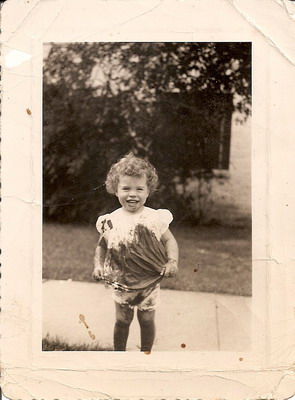This was such a paradigmatic example of Gendlin’s Focusing self-help technique (Focusing, Bantam, 1981,1984) and McGuire’s Intuitive Focusing, that I wanted to share it here. It includes Clearing A Space, deeper Focusing, and a huge bodily-felt shift, predicted to cause lasting change in “personality,” in how the person lives from then on.
It also ended up capturing something about this holiday season, the symbol of a young, struggling, “holy” family (Christian or not, it is this symbolism that touches me).
The turn happened on the Creative Edge Practice yahoo group where we are developing a model, a safe place for learning about Listening/Focusing directly in an email group. You can join us! Go to the link to read a description of the group.
In response to my Focusing turn, three different people offered Listening Reflection, each beautifully, empathically “holding and grasping” my message and giving it back to me, enriched by their own being-there in a Listening way. What an educational experience to be able to compare styles of Reflecting!
Here is the complete turn: it started slowly, me thinking only of Clearing a Space, moving into a deep Focusing, huge felt-shifting experience. The kaleidescope turned, and everything is newly in process:
“Okay, I am going to touch base with myself, as this holiday time (for me, my 62nd birthday Dec. 24, then Christmas, Dec. 25, New Years….) by Clearing A Space, just to see what is on my plate. No desperate issue to use Focusing with, but a sense of wanting to “take an inventory,” see what is there (Clearing A Space is Getting A Felt Sense Exercise #3, p.10 in Complete Focusing Instructions download you received, also on CD Intuitive Focusing Training, Track 10. You can find e-newsletters about it at E-newsletter archive, dates 10/12-11/1 ):
Phew!! All that teaching done, now turning toward myself, just beginning to follow my breathing as a way of coming inside my body— big breath, big sigh. Ahhhh!
—Got to slow down, give up “teaching” mind set, take time, take those whole “minutes” for finding the felt sense, not try to do this fast—
—-(long pause for felt sensing) Wow! (almost teary feeling) This holiday is almost here, after all these months of build up, and, if I am not careful, I am going to “miss it,” miss the “holiday” time-off, time for relationships, feeling of it ——
— Moving into a little Focusing here —- I am not really taking a full break —still doing email, blogging, website about three hours a day —what if I took a total break for the week from Christmas to New Years? —– tension in my shoulders — responsibility — also almost teary : “I would miss my email community — they are a large part of my “family” —-
—Many people also experiencing this “holiday,” not wanting a lot of emails — natural slow down?(doing some meridian tapping on sore spots each side of my collar bone: “I carry so much tension, even when I am trying to be on vacation —-TRYING!” (Big sigh, letting go of some tension—)
—Leaving further Focusing on that issue for another time. Back to Clearing A Space (I am looking for the peace, the “Except for all of that, I am completely okay!” experience that can come just with Clearing). (Big breath. Sigh. Releasing some tension). Ahhhh!
—Next issue that arises: Seeing my son, daughter-in-law, new grandson today— almost teary feeling — they are like Mary and Joseph — too young. They have a home, but not much else in the way of security — the world against them, too, in some way, because of their ADHD way of being (more teary here — pausing to sense into this. More of a sad sigh…)— some actual tears now, some relief in that symbolism — that there will be some angels and shepherds and wise men for them, too — some supports —that it is “not just me” trying to hold them up —WOW! That is an insight for me. Not to experience only all the hardship side but to see that there is some world-love, some world-support for them also—-NOT JUST ME (more teary feeling there. I will pause to be with that part — the strain I put on me to “hold them up” —)Big sigh—-
—My son will be at least yelled at at work, if not fired, because people stole something while he was cashier — it wasn’t totally his fault, but he was crying, stressed out, about it — but also angry about being blamed —
—And he is considering joining the military as a way to cope with this young family, all the bills….that is a big “weight” on me (I am drooping under the crush of it) Big Sigh. So, there is that. That is a heavy one — but I am reminded of the “support” symbolism above — the weight of that, the decision, whatever happens, it’s not all on my shoulders (ALL??? REally, in some way, none of it is on my shoulders —tears, sobbing, really, here —- I really cannot “remove this cross” from them. It is theirs to bear, not mine—much more sobbing there, nausea —- I would much rather be able to control it, to take it on, take care of it, make it come out alright —- more sobbing—-
(Had to get up and walk around. There is a huge physical pain shooting all up the sides of my torso, through my spine/ribcage, and sobbing about how I would rather carry it, even if stressful, than acknowledge that I really can’t control it, I can’t fix it— of course, logically, I know this — but THIS IS DIFFERENT. THIS IS LIKE AN EXPERIENTIAL, BODY-KNOWING THAT I CAN’T CONTROL IT. THIS COULD BE A BIG SHIFT, A BIG CHANGE IN MY MAJOR LIFE PATTERN OF TRYING TO CARRY EVERYTHING— so, I am going to breath into this and walk more, let this body-level shift happen more thoroughly—)
—This is big. I can’t even comprehend, really, what would come next as a way-of-being if I put this down, this idea that I am controlling/saving/holding up things, like whether people I love live or die, etc. — I’m thinking “This is what the Freudians mean by ‘secondary gain’ — what is the person gaining by having what looks like an unproductive pattern/behavior?” I’m feeling this experientially, as a body, not just a head, knowing — Big sigh. I need to take more time to “live into” this body-shifting—- Pause again, walking.
— Sitting, just breathing, feeling twinges shooting all through my body, loosenings, stretchings — but also part of me that wants to “crunch back up,” go back to thinking I am controlling things — but, I know that, fortunately, I guess, in real felt-shifting, like this is, there is no going back —-“The kaleidescope turns, and everything is new.” Darn!!! (meridian tapping those sore spots on collarbone again)
— A glimmering: “Well, silly, you weren’t really controlling things before either, with all that stress and tension. YOu just thought you were!!!!!!!”” (something in me starts shuttering here, shaking with fear — this is too scary for that part. I will be with that part now, turning compassionate, nurturing attention to it —–) Pause.
—I’m looking at a poster I have on the wall. It is a big pool of wavy water. Floating in the middle, a mother cradles her child in her hands. There are larger hands cradling those two. And really large hands cradling “all of that.” I want to comfort myself there, convince myself, believe that there are “larger hands” holding it all up:”S/he’s got the whole world in his/her hands,” the song says —- Ahhhh! More pausing to “sit with” all of this — the scared part, the letting go, the hope that there is love/support in this world so harsh for these young parents — some teariness there—Ahhhh!
—still too scary — thinking of my child going off to Afghanistan or Iraq, him thinking he is going to work on computers and come out getting a job for $120,000!!!! Too young. Too innocent to face these huge decisions…but also very stubborn. Very much needing to “do it myself.” And, yes, it is his destiny. I cannot do it for him. It ruins the very “thing,” the “selfhood” for him if I try to decide for him. Sigh….
—I can’t do anymore with this place now. Need it to rest. Trust the continuing bodily shifting. Ahhh!
— Sense that there is this whole “other thing” on my plate. Where I thought I would spend my Focusing time. This whole issue about my work, what new projects I should take on, what leave alone. How be less stressed. I’m not going to go there now. Another time. But I know they are related. Saving my son. Saving the world. It’s all part of that same “life script” :”I can hold it all up. I can change it all. I can save everybody, if I just work hard enough.” Big sigh!!!
I’m stopping here! Another huge post, huge Focusing turn come out of Clearing a Space. I do feel lighter. My spine straighter, my body less hunched over with carrying it all. I am optimistic! I trust this felt-shifting, carrying forward process. I know it is in the “direction of righting,” wholeness.
I do feel finished. I do not need reflection. But, of course, it is always welcome. It is always nice to ALSO be heard, as well as hearing myself. And, of course, this group is a place to practice Reflecting, so I’m game for any person to try it, perhaps with just some small part…or not! It’s vacation!
Warmly, and thanks for Listening, “holding this space.” I would not do this Focusing at all this well or deeply “alone”.
Kathy
—Learn more about Intuitive Focusing and Focused Listening and Experiential Focusing Therapy at Creative Edge Focusing’s website, filled with free downloads on creativity, spirituality, collaborative thinking, parenting, innovation in business, and many other aspects of application of Focusing and Listening skills at home, at work, in your community, and globally.
See actual demonstrations of Listening/Focusing in our Self-Help package, a manual in English or Spanish, four CDs of Focusing Instructions, and a DVD with four demonstrations of actual listening/focusing sessions — everything you need to start your own Listening/Focusing Partnership or Support Group or to incorporate these basic self-help skills into existing support groups.
In the side bar at Creative Edge Focusing, subscribe to our free e-newsletter for weekly reminders to practice Relaxation and Focusing exercises and join our free yahoo group, Creative Edge Practice, for ongoing demonstrations, practice, and support.
Find classes/workshops/phone coaching in our Listings section or Coaching/Classes/Consulting with Dr. McGuire
Dr. Kathy McGuire, Director
Creative Edge Focusing (TM)
www.cefocusing.com
The site of new insights and creative solutions is at the edge of what is already known. This edge, The Creative Edge, holds implicit within it all past and future knowing about the problem, more than could ever be put into words in a linear way

